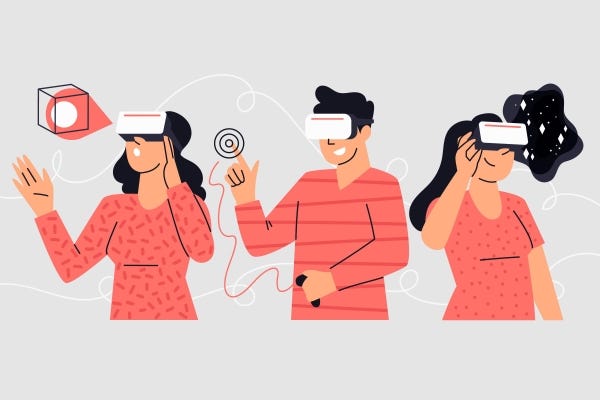Virtual Reality (VR) is a cutting-edge technology that creates immersive, computer-generated environments that users can interact with as if they were physically present within those digital realms. It is designed to engage multiple human senses, primarily vision and hearing, to transport individuals into simulated worlds or scenarios.

How Virtual Reality Works
- The virtual Reality (VR) era creates immersive digital reports through the use of specialised systems and software. Users put on a VR headset that tracks their head moves and displays 3-D pix on monitors in front of their eyes. These photographs mimic the real global, making customers experience like they may be in an exceptional vicinity. VR additionally includes 3-D sound for a practical audio reveal.
- Users can interact with the virtual global through the use of controllers or hand actions, and some VR structures even provide touch remarks. It all takes place with the assistance of powerful computer systems and software that generate those virtual environments. VR isn’t just for gaming; it’s used in fields like architecture, medication, and education to provide realistic simulations and schooling. So, when you put on a VR headset.
Types of Virtual Reality
Virtual Reality (VR) technology comes in various forms, each with its own unique experiences and uses:
- Immersive VR: This is the most common VR type, where you wear a headset to feel completely inside a virtual world, often used in games and training.
- Non-Immersive VR: You interact with a 3D virtual world on a computer screen without wearing a headset, used in design and education.
- Augmented Reality (AR): AR adds digital stuff to the real world, like Pokémon GO or Snapchat filters, often seen on smartphones or AR glasses.
- Mixed Reality (MR): MR combines digital things with the real world, handy for product design and architecture.
- 360-Degree Video: These videos let you look around in all directions, great for storytelling and virtual tours.
- WebVR: No need for fancy VR gear; you can access VR on web browsers for various purposes.
- Mobile VR: Use your smartphone with affordable VR headsets for on-the-go experiences.
- Simulator Rides: Theme parks use this to make thrilling rides with VR.
- Social VR: Hang out with friends in virtual worlds for chatting and gaming.
- Therapeutic VR: Doctors use VR to treat conditions like PTSD and phobias.
Applications of Virtual Reality
Virtual Reality (VR) finds applications across various industries, including gaming, education, healthcare, architecture, tourism, marketing, automotive, military, aerospace, retail, art, social interaction, real estate, mental health, sports, and environmental awareness. It enhances experiences by immersing users in digital environments, facilitating training, therapy, design visualization, and interactive storytelling. VR continues to evolve, promising transformative advancements in entertainment, education, and beyond.
Virtual Reality Hardware
Virtual Reality (VR) hardware is made up of special gadgets and parts designed to give you amazing and interactive virtual experiences. The important things in VR hardware include:
- Head-Mounted Display (HMD): Think of this as the VR glasses you wear. They have screens for your eyes and sensors to follow your head movements, making the virtual world seem real.
- Motion Tracking Sensors: These sensors keep an eye on how you move. They help the virtual world respond when you look around or move, making it feel like you’re really there.
- Controllers: These are like VR remote controls. They have buttons and sensors to copy your hand movements, so you can interact with the virtual world.
- Base Stations: These are like VR GPS markers. They help track where your HMD and controllers are in the room. This makes it possible to move around in the virtual world.
- Audio Systems: VR uses special sound systems to make things sound real. You might use headphones to hear 3D sounds that match what you see.
- Computer Hardware: VR needs a powerful computer or game console to create detailed 3D graphics. Fast processors, strong graphics cards, and lots of memory are a must for a great VR experience.
- Cables and Connectors: VR gear is usually connected with cables, although some are wireless. Cables are like the wires that connect everything together.
Conclusion
In conclusion, Virtual Reality (VR) is a revolutionary technology that has transformed the way we experience digital content. It immerses users in virtual worlds, blurring the lines between the real and the digital. With its diverse applications across industries such as gaming, education, healthcare, design, and more, VR has become a powerful tool for entertainment, learning, and problem-solving.
FAQs About VR
VR works by using specialized hardware and software to create immersive, interactive, and three-dimensional environments. Users wear an HMD to see and sometimes hear the virtual world, while motion tracking sensors capture their movements for real-time interaction.
VR (Virtual Reality) completely immerses users in a virtual environment, while AR (Augmented Reality) overlays digital content onto the real world. VR replaces the real world with a virtual one, while AR enhances the real world with digital elements.
VR comes in various forms, including immersive VR (with HMDs), non-immersive VR (on computer screens), augmented reality (AR), mixed reality (MR), 360-degree video, and more, each offering different levels of immersion and interactivity.
VR has applications in gaming, education, healthcare, architecture, training, marketing, entertainment, therapy, and more. It is used for immersive experiences, simulations, and training programs in various fields.
Related posts:
- AMC Full Form: Benefits, Components, Needs, Advantage
- ORS Full Form: Dehydration, Myths, Flavors, Varieties & Facts
- PCC Full Form: Importance, Types, Application Process
- PAN Full Form: Legal Provisions, Regulations,
- BRB Full Form: Productive, Routine, Distractions
- MCD Full From: Introduction, Responsibility, Challenges
- CT Scan Full Form: Scans, price, Advantages
- USA Full Form: History, Economics,Technology, culture




















